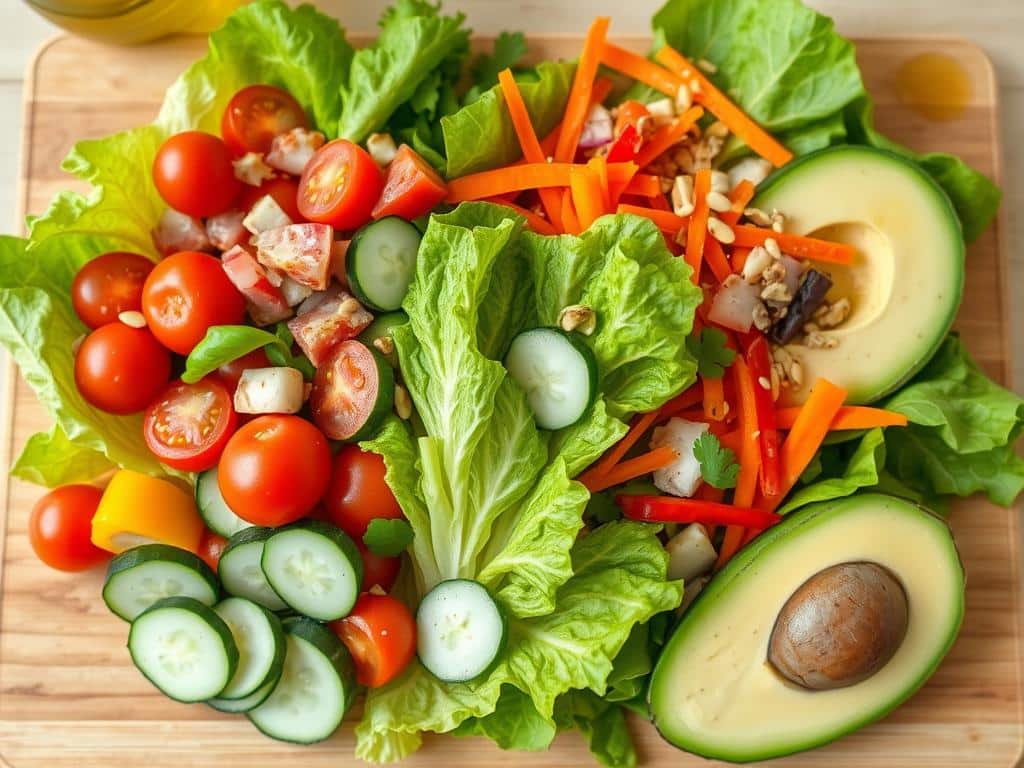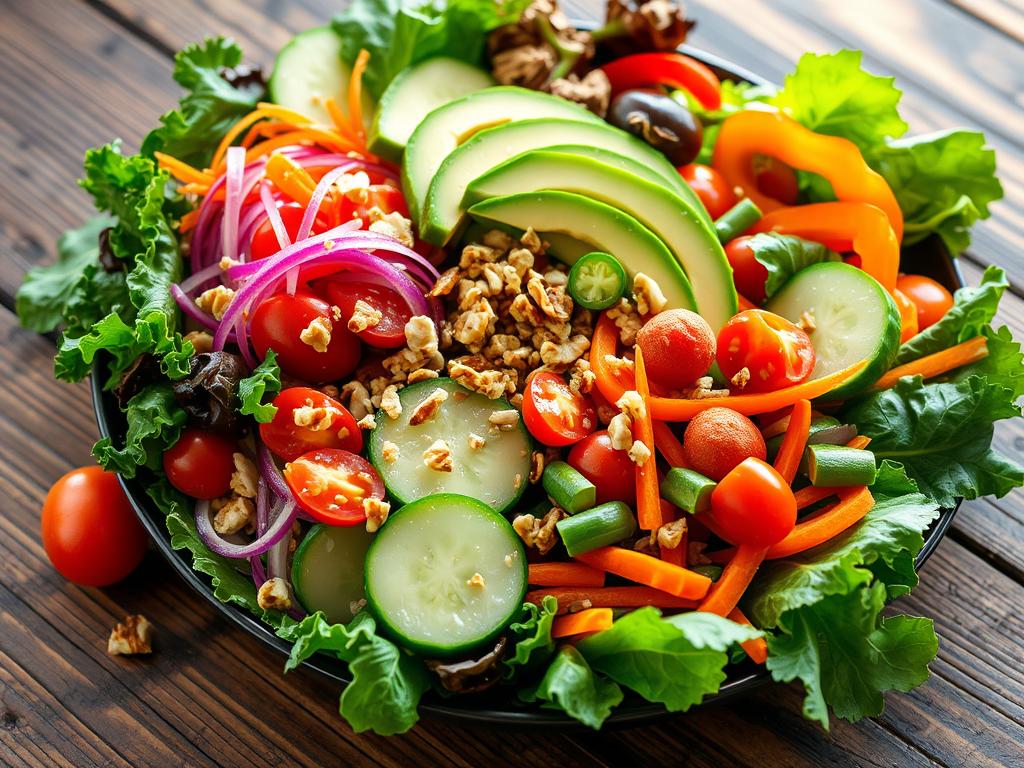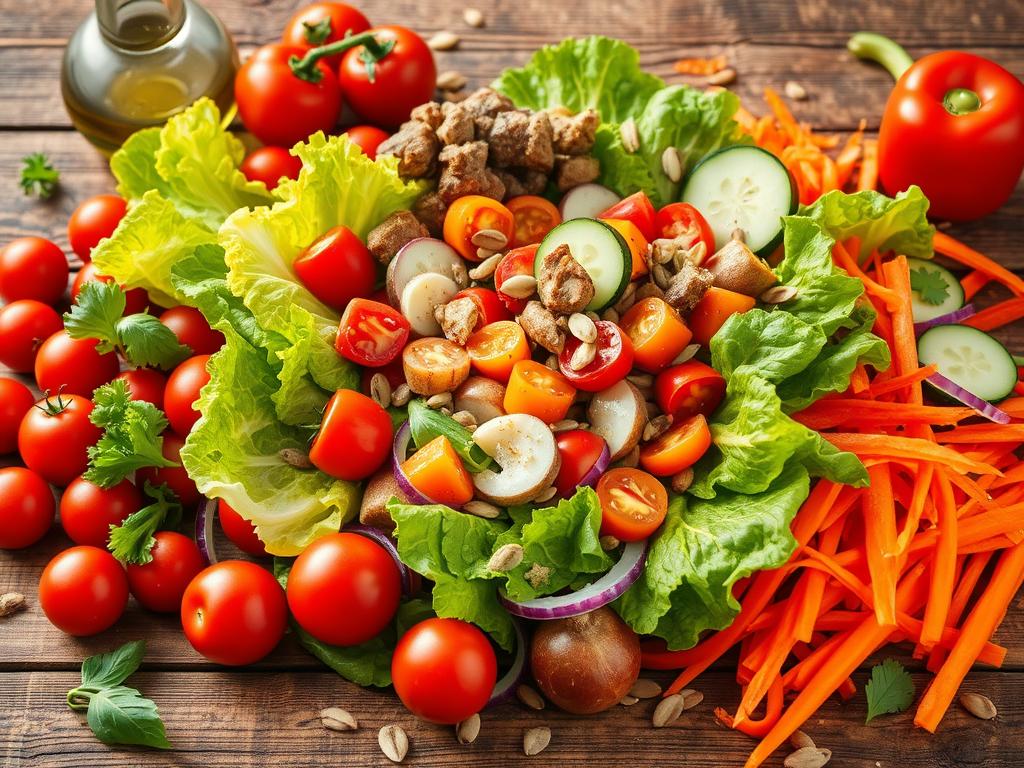As the warm weather comes, we all crave lighter, healthier meals. Imagine a salad that’s not just tasty but also helps you lose weight. This health salad recipe is a true delight for your body and soul.
I learned the power of a great salad in my own weight loss journey. No more boring greens for me. Instead, I enjoy a mix of flavors, textures, and nutrients that make me feel full and energized. I want to share this experience with you, helping you find healthier meals and a happier life.
Table of contents
- Key Takeaways
- Why Choose a Healthy Salad for Weight Loss?
- Key Ingredients for Your Health Salad Recipe
- Essential Dressing Options for Your Salad
- Step-by-Step Guide to Building Your Salad
- Meal Prep: Making Salads Ahead of Time
- Variations on Your Health Salad Recipe
- Incorporating Your Salad into Daily Meals
- The Role of Salads in a Balanced Diet
- Tips for Enhancing Salad Flavor
- Common Mistakes to Avoid with Salads
- Conclusion: Your Journey to Healthier Eating
- FAQ
Key Takeaways
- This health salad recipe contains at least 15 grams of protein and 6 grams of fiber per serving, with no more than 575 calories.
- The salad features a variety of fresh, seasonal ingredients like crisp peas, earthy beets, and hearty greens, making it perfect for spring and summer meals.
- The recipe is easy to make and can be customized to suit your taste preferences and dietary needs.
- Incorporating this salad into your weekly meal plan can support your weight loss goals and provide a nutrient-dense boost to your overall well-being.
- With its balance of essential macronutrients and a variety of superfoods, this health salad recipe can be an integral part of a balanced and sustainable diet.
Why Choose a Healthy Salad for Weight Loss?
Adding a healthy salad to your daily meals can really help with weight loss. These salads are full of fresh, healthy ingredients. They offer many benefits that help you on your weight loss journey.
Nutritional Benefits of Fresh Ingredients
Leafy greens, crisp veggies, and superfoods like kale and avocado are key in a healthy salad. They are packed with vitamins, minerals, and antioxidants. These nutrients nourish your body and boost your overall health.
Eating raw veggies like carrots and spinach can also improve your mood and mental health.
Low-Calorie Options
Salads are naturally low in calories, making them great for losing weight. By using ingredients like leafy greens and cucumbers, you can make filling meals. These meals won’t stop you from reaching your weight loss goals.
The health salad recipe mentioned here have received 5-star reviews. They are low in calories but high in protein and fiber. This makes them perfect for healthy weight loss.
High Fiber Content
Many salad ingredients, like leafy greens and raw veggies, are high in fiber. This fiber helps you feel full and aids digestion. Ingredients like kale and avocado can slow down digestion, helping you feel full longer.
Choosing a healthy salad gives your body the nutrients it needs while keeping calories low. Adding different fresh toppings can turn your salad into a superfood-packed meal. This supports your weight loss goals.

Key Ingredients for Your Health Salad Recipe
Making a healthy salad begins with picking the right ingredients. You need fresh, tasty items for a balanced protein-packed salad, fiber-rich salad, or antioxidant salad.
Leafy Greens to Include
Start with a base of leafy greens. Choose spinach, kale, arugula, romaine lettuce, or mixed greens. These greens are full of vitamins, minerals, and antioxidants.
Fresh Vegetables and Their Benefits
Adding fresh veggies makes your salad colorful and crunchy. Try cucumbers, cherry tomatoes, bell peppers, carrots, and radishes. They add fiber and antioxidants.
Protein Sources for Energy
For a protein-rich salad, add lean proteins like grilled chicken, shrimp, or hard-boiled eggs. Tofu or beans are great plant-based options. They keep you full and energized.
Healthy Fats That Satisfy
Healthy fats like avocado, nuts, and seeds make your salad tasty and nutritious. They help you feel full and improve nutrient absorption.
By choosing the right mix of greens, veggies, proteins, and fats, you get a salad that’s good for you and delicious.
Essential Dressing Options for Your Salad
Choosing the right dressing is key to a healthy salad. Homemade dressings let you control what goes in, making them healthier. You can pick from light vinaigrettes to creamy yogurt-based ones, making your salad better.
Homemade vs. Store-Bought Dressings
Homemade dressings are healthier than store-bought ones. They avoid processed additives and extra salt or sugar. You can use olive oil, lemon juice, and fresh herbs to make them just right for you.
Light and Healthy Dressing Recipes
- Balsamic Vinaigrette: A mix of balsamic vinegar, olive oil, Dijon mustard, and honey.
- Lemon Vinaigrette: It’s bright and tangy, with lemon juice, olive oil, and garlic.
- Tahini Dressing: Creamy and nutty, made with tahini, lemon juice, and water.
- Greek Yogurt Dressing: Cool and refreshing, with Greek yogurt, herbs, and red wine vinegar.
Tips for Portion Control with Dressings
Watch how much dressing you use, as healthy options can add calories. Use no more than 2 tablespoons per serving. Try drizzling a little dressing and add more if needed.
By trying homemade and light dressings, you can enjoy your salad’s flavors without adding too many calories. This is great for weight loss and staying healthy.
Step-by-Step Guide to Building Your Salad
Making a tasty and healthy salad is like an art. It needs careful prep and attention to detail. Whether you want to lose weight or eat healthier, knowing how to assemble a salad is key. Let’s explore how to make your ideal salad, from getting your ingredients ready to presenting it beautifully.
Preparing Your Ingredients
First, wash and dry your greens well. This makes sure your salad base is fresh and clean. Then, cut your veggies into the same size pieces. This helps spread the flavors evenly. For protein, you can use grilled chicken, roasted chickpeas, or hard-boiled eggs.
Layering for Maximum Flavor and Nutrients
Start with a big base of greens. This gives your salad a strong foundation. Add your chopped veggies next, followed by your protein. Finish with toppings like nuts, seeds, or dried fruit for extra crunch and nutrition.
Presentation Tips for Visual Appeal
How you present your salad matters a lot. Arrange your ingredients in a way that looks good. Use different colors and textures to make it stand out. Drizzle your dressing just before serving to keep the greens crisp.
By following these steps, you’ll make a healthy salad that’s both nourishing and tasty. The secret to a great salad is balancing flavors, textures, and looks. Enjoy making your salad!
Meal Prep: Making Salads Ahead of Time
Meal prepping healthy salads is a game-changer for a balanced diet and weight loss goals. It saves time, controls portions, and keeps nutritious meals ready all week.
Benefits of Meal Prepping
Meal prepping salads has many benefits:
- Saves time during the busy workweek
- Allows for better portion control and reduced food waste
- Ensures you have access to healthy, nutrient-rich meals
- Reduces the temptation to reach for less healthy options
Safe Storage Practices
To keep your meal prep salads fresh and flavorful, follow these storage tips:
- Store ingredients separately in airtight containers
- Keep dressings and other liquid components separate until ready to serve
- Use mason jars for layered salads, placing the dressing at the bottom and the greens on top
- Incorporate sturdy vegetables like carrots and bell peppers that stay crisp longer
- Prepare proteins in advance and add them to the salads just before eating
Creative Ways to Keep Salads Fresh
With a little creativity, you can enjoy your healthy lunch ideas all week. Try these tips:
| Salad Idea | Nutrition Facts (per serving) |
|---|---|
| Salad with Coleslaw Mix & Rotisserie Chicken | 286 calories, 13g fat, 47mg cholesterol, 835mg sodium, 23g carbohydrate, 21g protein |
| Salad Bowl with Rice, Veggies & Feta Cheese | 433 calories, 25g fat, 8mg cholesterol, 1355mg sodium, 44g carbohydrate, 8g protein |
| Dinner Salad with Steak | 321 calories, 25g fat, 55mg cholesterol, 529mg sodium, 7g carbohydrate, 18g protein |
By following these strategies, you can enjoy delicious, meal prep salads all week. They keep you energized and satisfied.

Variations on Your Health Salad Recipe
Try new health salad recipe to boost your healthy eating. You can find salads for every taste, from seasonal to global flavors. There’s something for everyone.
Themed Seasonal Salads
Make the most of each season with themed salads. In spring, use strawberries, asparagus, and greens. Summer brings tomatoes, avocado, and cucumber.
Fall is for pumpkin, apples, and kale. Winter salads feature hardy greens, roasted veggies, and citrus.
Global Influences: Flavors from Around the World
Add a global twist to your salads. For a Mediterranean vibe, add feta, olives, and oregano. Asian salads include edamame, sesame seeds, and sesame-ginger dressing.
Latin American flavors come from chili-lime chicken, avocado, and cilantro vinaigrette.
Customizing for Dietary Preferences
Make salads fit your dietary needs. For vegetarian and vegan diets, use chickpeas, tofu, or mushrooms. Gluten-free options include quinoa or brown rice.
Incorporating Your Salad into Daily Meals
Salads are great for adding nutrition to your meals. You can have them as a big meal for lunch or dinner. Or, you can have a smaller salad as a tasty side dish.
Adding lean proteins or whole grains to your salad makes it even better. It turns into a full and satisfying meal.
Best Times to Enjoy a Salad
Make salads a part of your daily meals. Start with a power breakfast salad to get your veggies in early. For lunch or dinner, have a big salad as your main dish.
Or, for a lighter meal, try a side salad with your main course.
Pairing Salads with Other Dishes
Salads go well with many meals. Add lean proteins like grilled chicken, tuna, or shrimp on top. This makes your salad a filling main course.
Try a Mediterranean-inspired salad with whole grains like quinoa or couscous. For something more filling, add roasted vegetables or legumes to your salad.
Making Salads a Family Affair
Get your family involved in making salads. Set up a salad bar with lots of fresh ingredients. Let everyone make their own healthy, family-friendly salads.
The Role of Salads in a Balanced Diet
Salads are key to a balanced diet. They are full of fiber and vitamins. They help with weight management and boost overall health.
Portion Control with Salads
Salads help with portion control. They are low in calories but fill you up with their veggies and fruits. This is great for those trying to lose weight.
Combining Salads with Other Food Groups
Salads are even better when mixed with other foods. Adding lean proteins like chicken or chickpeas gives you energy. Healthy fats from avocado or nuts help your body absorb vitamins.
The Importance of Variety
It’s important to mix things up with salads. Changing up greens, veggies, fruits, and toppings keeps meals interesting. It also makes sure you get a wide range of nutrients.
For a healthy lifestyle, focus on salads. They are packed with nutrients. Adding them to your meals can lead to a better, more fulfilling life.
Tips for Enhancing Salad Flavor
Making a flavorful salad is an art. With a few simple tips, you can make your flavorful health salad recipe stand out. From the right mix of herbs and spices to the freshness of ingredients, let’s dive into how to make your salads pop.
Herbs and Spices to Add Zing
Fresh herbs like basil, cilantro, or mint can boost your salad’s flavor. Try spices like cumin or paprika for depth. These salad seasoning tips can turn a simple salad into a flavor explosion.
The Power of Fresh Ingredients
High-quality, fresh ingredients are key to a great salad. Look for locally-sourced produce or trusted suppliers. This ensures your veggies, greens, and fruits are the freshest and tastiest.
Textural Contrast for Better Enjoyment
Salads need a mix of textures for the best experience. Add crunchy nuts or seeds, and roast veggies for sweetness. The right mix of textures makes your salad a joy to eat.
Mastering these salad seasoning tips and using fresh ingredients can make your salads a hit. Experiment, explore, and enjoy making healthy, tasty salads that please your body and senses.
Common Mistakes to Avoid with Salads
Making a great salad is an art. It’s key to avoid common mistakes to get the most health benefits. As you start making salads, watch out for these common errors.
Overloading on Dressings
Many people use too much dressing in their salads. A good dressing can make your salad better, but use it sparingly. Aim for no more than 2 tablespoons per serving. Too much dressing can make your salad high in calories, which can hurt your weight loss plans.
Skipping Protein or Healthy Fats
Protein and healthy fats are vital for a filling and nutritious salad. Skipping them can make you feel hungry and might slow down your weight loss. Add lean proteins like grilled chicken or chickpeas, and healthy fats like avocado or olive oil dressing. This will keep you full and give you energy.
Neglecting to Season Properly
Don’t let your salad taste bland because of bad seasoning. Seasoning your greens and other ingredients with herbs, spices, and a bit of salt can make a big difference. Avoid using only iceberg lettuce, which isn’t as nutritious as spinach or kale.
By avoiding these mistakes, you’ll make healthy, tasty salads that help you lose weight and keep your body nourished. With a bit of care, you can turn a simple salad into a delicious meal.
Conclusion: Your Journey to Healthier Eating
Starting your journey to healthier eating is a big step. Adding nutritious salads to your daily meals can change your life. By setting realistic goals, you can build lasting habits that make you feel better.
Setting Realistic Goals
Begin by setting goals that feel achievable. Maybe you want to lose weight, feel more energetic, or have better digestion. Make a plan that fits your life and needs. Remember, small steps lead to big success.
Encouraging Consistency in Healthy Choices
Staying healthy can be tough, but it’s doable with planning and creativity. Try meal prepping salads or trying new recipes. Use fresh ingredients and flavors to keep things exciting and motivating.
Celebrating Your Progress with Delicious Salads
As you make progress, celebrate your wins. Enjoy delicious salads with your favorite ingredients. Each bite is a reminder of your health journey. Take pride in the positive changes you’re making.
FAQ
What is the Healthiest Salad I Can Eat?
The healthiest salad combines nutrient-dense ingredients that provide a balance of vitamins, minerals, fiber, and healthy fats while avoiding excessive calories or added sugars. Here’s a simple formula for a healthy salad:
- Base: Dark leafy greens like spinach, kale, or arugula.
- Vegetables: A variety of colorful options like carrots, bell peppers, cucumbers, cherry tomatoes, and broccoli.
- Protein: Grilled chicken, tofu, chickpeas, hard-boiled eggs, or salmon.
- Healthy Fats: Avocado slices, nuts, seeds, or a drizzle of olive oil.
- Complex Carbs: Quinoa, farro, or sweet potato for added energy.
- Dressing: A homemade vinaigrette with olive oil, lemon juice, and herbs to avoid unhealthy additives.
This combination provides a filling, nutritious, and well-rounded meal.
What Are the Five Types of Salads?
The five types of salads are classified based on their primary ingredients or purpose:
- Green Salads: Made with leafy greens (e.g., Caesar salad, garden salad).
- Vegetable Salads: Focus on non-leafy vegetables like cucumbers, tomatoes, and bell peppers (e.g., Greek salad).
- Protein-Based Salads: Feature a protein source like chicken, tuna, eggs, or tofu (e.g., Cobb salad, chicken salad).
- Grain or Pasta Salads: Use grains or pasta as the base, often combined with vegetables and proteins (e.g., quinoa salad, pasta salad).
- Fruit Salads: Consist of fresh fruits, sometimes with yogurt or a light dressing (e.g., tropical fruit salad).
What to Add to Salad to Make It More Filling?
To make a salad more filling, include ingredients that are rich in protein, fiber, and healthy fats:
- Proteins: Grilled chicken, shrimp, tofu, hard-boiled eggs, canned tuna, or lentils.
- Fiber-Rich Foods: Beans (e.g., chickpeas, black beans), whole grains (e.g., quinoa, farro), or roasted vegetables.
- Healthy Fats: Avocado, nuts (e.g., almonds, walnuts), seeds (e.g., sunflower, chia), or olive oil.
- Dairy: Shredded cheese, feta, or a dollop of Greek yogurt.
- Complex Carbohydrates: Sweet potatoes, roasted butternut squash, or whole-grain croutons.
These additions ensure your salad is satisfying and keeps you full longer.
What Are Unhealthy Salad Toppings?
Certain toppings can turn a healthy salad into a calorie-laden meal:
- Sugary Dressings: Store-bought dressings like honey mustard, ranch, or Thousand Island can contain added sugars and unhealthy fats.
- Fried Toppings: Fried chicken strips, crispy bacon, or fried onions add unhealthy fats and extra calories.
- High-Fat Cheese: Excessive amounts of cheese like cheddar or blue cheese can increase saturated fat.
- Candied Nuts: Often coated in sugar and oils, candied nuts can negate their nutritional benefits.
- Croutons: Made with refined flour and often fried or heavily seasoned.
- Excess Dried Fruits: While nutrient-dense, dried fruits are high in sugar and calories, especially when sweetened.
Choosing fresh, whole-food ingredients and controlling portions can keep your salad healthy and nutritious.

